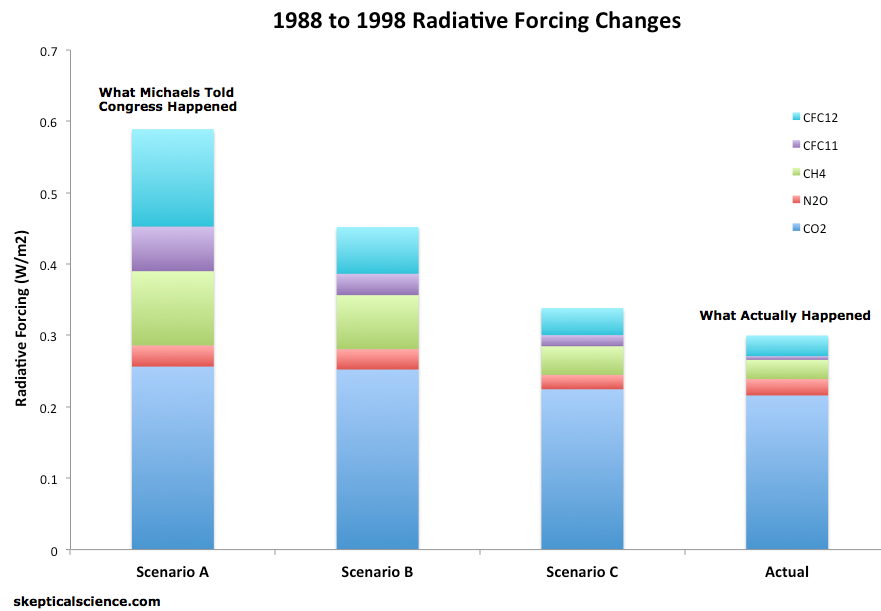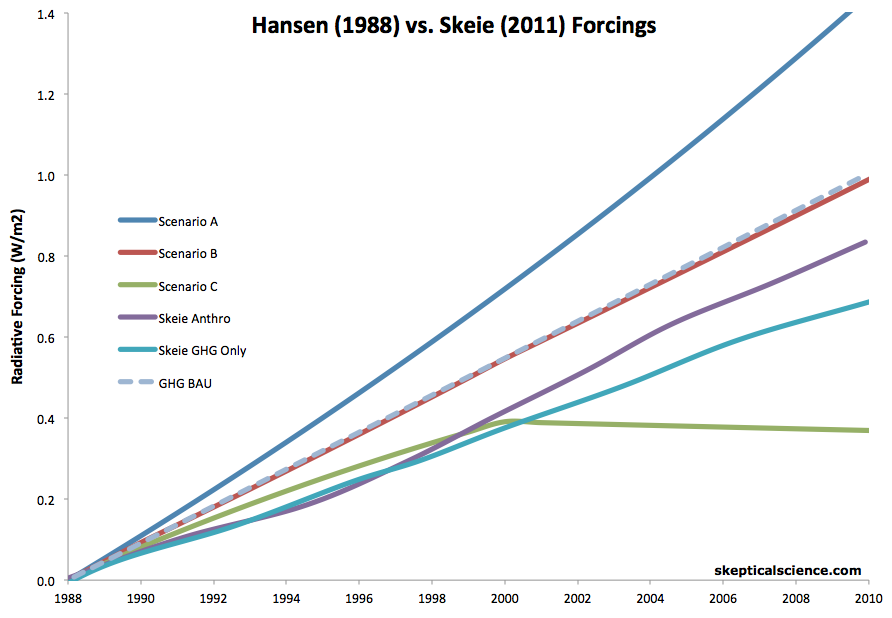Patrick Michaels Continues to Distort Hansen 1988, Part 1
Posted on 24 January 2012 by dana1981
We recently examined three examples of Patrick Michaels deleting inconvenient data in his presentations of other scientists' research. The first and most egregious of these examples occurred in 1998, when Michaels testified before Congress and deleted two of the three global warming projections from Hansen et al. (1988). Rather than admit and apologize for this blatant distortion of the work of Hansen and colleagues, Michaels has responded by attempting to defend the indefensible. However, his excuses for deleting Hansen's Scenarios B and C are based on erroneous assumptions as detailed below. Consequently, his presentation to Congress remains a distortion of Hansen's actual results.
Figure 1: Radiative forcing contributions from 1988 to 1998 from CO2 (dark blue), N2O (red), CH4 (green), CFC-11 (purple), and CFC-12 (light blue) in each of the scenarios modeled in Hansen et al. 1988, vs. observations (NOAA).
Michaels' Excuses
Michaels' attempted to defend his deletion of Scenarios B and C as follows:
"I elected to focus on a comparison between the observed temperatures and those projected to have occurred under Hansen’s (in his words) “business-as-usual” (BAU) scenario."
This is the same defense Michaels put forth in 2006 when similarly accused of fraudulently misrepresenting the results of Hansen et al. in his congressional testimony. You can read Tim Lambert's response to this defense here.
At face value, Michaels' self-defense seems like a reasonable explanation. On the one hand, in Hansen et al. (1988), Scenario B is described as the most likely to occur (Section 4.1, Page 9345):
"Scenario B is perhaps the most plausible of the three cases"
However, in Hansen's 1988 Congressional testimony, he did describe Scenario A as "business as usual," as Michaels asserts. But in his latest blog post, Michaels inadvertently touched upon a key point which made his testimony very, very wrong.
The Montreal Protocol
Michaels continued by describing exactly where his "BAU" assumption was false:
"Remember, this was in 1998. There was no worldwide treaty reducing carbon dioxide emissions (indeed, there isn’t one now). The only change to BAU that took place in the 1988 to 1998 time period was the Montreal Protocol limiting the emissions of CFCs."
The main difference between Hansen's emissions Scenarios A and B for the first several decades does not involve CO2. In fact, atmospheric CO2 concentrations differ by less than 3 parts per million in 2010 between his Scenarios A and B. No, the main difference between the scenarios involves the other greenhouse gases, primarily chlorofluorocarbons (CFCs). In fact, CFCs account for 75% of the difference in radiative forcings from 1988 to 1998 between Scenarios A and B (see Figure 1).
In 1987, in order to address the problem of ozone depletion (also caused by CFCs), the Montreal Protocol international agreement to reduce CFC emissions was ratified, and the emissions reductions began to take effect in the 1990s.
In addition, worldwide events between 1988 and 1998, such as the collapse of the Soviet Union and tearing down of the Berlin Wall, resulted in reduced global CO2 emissions from the burning of fossil fuels. Michaels' assumption that emissions continued on a "business as usual" path is without merit. It should go without saying that testifying before Congress based on nothing more than unverified assumptions is generally very poor practice for any self-proclaimed expert.
Business As Usual
Michaels' entire self-defense is based on Hansen's "business as usual" comment, and his own assertion that no significant steps were taken to reduce greenhouse gas emissions between 1988 and 1998. However, what did Hansen mean by "business as usual"?
Leading up to 1988, CFC-11 was rising at a fairly linear rate of approximately 10 parts per billion (ppb) per year, and CFC-12 by approximately 18 ppb per year. This rate of increase is consistent with Hansen's Scenario B (see Figure 2 below). Scenario A involved accelerating CFC emissions, so perhaps calling Scenario A "business as usual" was a poor characterization, which would be more apt for Scenario B. In his 1988 peer-reviewed paper, Hansen had described Scenario A as (Section 4.1, Page 9345):
"Scenario A, since it is exponential, must eventually be on the high side of reality"
Perhaps a better description of Scenario A would be "worst case scenario." Regardless, since the Montreal Protocol was implemented prior to Michaels' 1998 testimony, and other major events like the Soviet Union collapse transpired, it was not accurate for him to claim that greenhouse gas emissions had followed a "business as usual" path. In his self-defense blog post, Michaels claimed:
"Reductions in [CFC] production began only in 1994 and the radiative effect of the Protocol by 1998 was infinitesimal."
This is simply wrong, and Michaels has not even attempted to support this false assertion. In fact, CFC-11 and CFC-12 atmospheric concentrations only rose by 2 and 9 ppb per year from 1988 to 1998, respectively, on average. This is a far slower rate than leading up to 1988 because of the successful implementation of the Montreal Protocol's CFC emissions phase-out. Additionally, the other events mentioned above resulted in lower CO2 emissions between 1988 and 1998 than were modeled in either Scenario A or B; they were close to Scenario C levels.
In fact, as Figure 1 shows, the radiative forcing caused by the actual net greenhouse gas emissions from 1988 to 1998 (according to NOAA) was not only below Scenario A, but also below Scenario B, and even slightly below Scenario C. Most of the difference was due to low CFC emissions, as well as some contribution from relatively low methane (CH4) emissions, and some contribution from low CO2 emissions.
In short, while Hansen's characterization of Scenario A as "business as usual" was arguably a poor choice, we nevertheless did not follow a business as usual emissions path between 1988 and 1998, and therefore the asserted basis of Michaels' self-defense for deleting Scenarios B and C is false.
Actual Emissions
The other major problem with Michaels' 1998 congressional testimony was in the way he presented Scenario A:
"That model predicted that global temperature between 1988 and 1997 would rise by 0.45°C...The forecast made in 1988 was an astounding failure"
This is simply a gross misrepresentation of Hansen's actual research. First, the model did not predict temperature changes, it projected them. The difference is a critical one. Climate scientists cannot predict how human greenhouse gas emissions will change in the future, which is a question for the public and policymakers. For example, we cannot expect Hansen to have predicted the Soviet Union collapse, or how successful the Montreal Protocol would be. All climate scientists can do is project the climate effects for a given emissions scenario.
Michaels claim that Hansen's Scenario A projection was "the model prediction" was wrong. It was one of the model predictions, based on a worst case emissions scenario which did not come to pass.
If only one of Hansen's emissions scenarios were to be presented as the model prediction, it must be the scenario most representative of actual real-world emissions.
So which scenario was the most accurate representation? Figure 2 below provides the answer. The radiative forcings for Hansen's three scenarios were estimated using the simplified radiative forcing expressions from the 2001 IPCC report, based on the projected greenhouse gas atmospheric concentrations for Hansen's scenarios. The actual radiative forcing estimates are taken from Skeie et al. (2011).
Hansen et al. only modeled the temperature response to greenhouse gas changes (and a few simulated volcanic eruptions). So in his simulations, the GHG-only forcing and 'all forcings' are the same. In reality, they are not, with the main non-GHG forcing involving human aerosol emissions, whose effects remain one of the biggest uncertainties in climate science.
In our analysis here, we're interested in the changes since 1988, particularly through 1998. The radiative forcing changes since 1988 are shown in Figure 2.
Figure 2: Radiative forcing changes (1988 to 2010) for the three emissions scenarios in Hansen et al. 1988 (dark blue [A], red [B], and green [C]) vs. Skeie et al. (2011) GHG-only (light blue) and all anthropogenic forcings (purple), and business as usual (BAU) GHG based on a rate of increase consistent with the Skeie et al. estimate for 1978 to 1988 (gray, dashed).
Both the GHG-only and net anthropogenic forcing changes between 1988 and 1998 were very close to Hansen's Scenario C, consistent with Figure 1 above, primarily due to the CFC emissions reductions as a result of the Montreal Protocol. Business as usual GHG emissions, on the other hand, would have been on pace with Hansen's Scenario B.
In short, while Hansen was arguably wrong to call Scenario A "business as usual," Michaels' false assertion that emissions had continued on a business as usual path was (and still is) without basis, and in the process, he grossly misrepresented Hansen's research. Michaels could easily have at least checked the Mauna Loa CO2 data to see which of Hansen's scenarios it was consistent with, but Michaels did not even do this simple check to support his false assumptions.
Over 13 years later, even when the distortion has been pointed out many times, Michaels continues to make this false and easily debunked argument. Before putting forth the nonsense 'BAU' argument once again, Michaels could very easily have checked the data and discovered that on average between 1979 and 1988, the GHG forcing increased 2.5% per year, versus 1.5% per year from 1988 to 1998. Not only is this not exponential growth (as in Scenario A), but it's not even maintaining linear growth (as in Scenario B). The data are not hard to find, so why has Michaels not even attempted to support his 'BAU' claim, and what does it say about him that he hasn't?
In Part 2, we'll examine what Michaels' presentation to Congress should have looked like, had it been accurate, and what this tells us about the accuracy of Hansen's climate model and real-world climate sensitivity.































 Arguments
Arguments

























 0
0  0
0 [Source]
What happened between 1988 and 1998 was not BAU as Michaels claimed-- Michaels was flat out wrong.
[Source]
What happened between 1988 and 1998 was not BAU as Michaels claimed-- Michaels was flat out wrong.







Comments